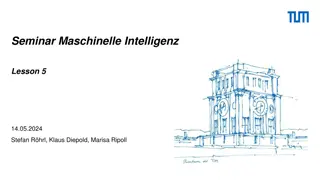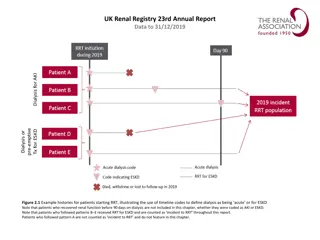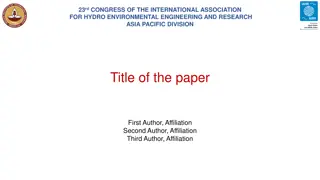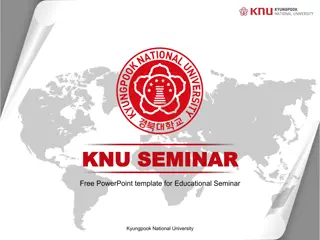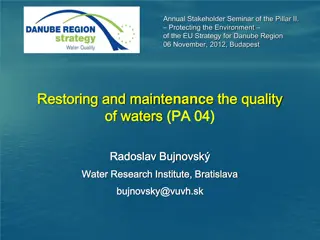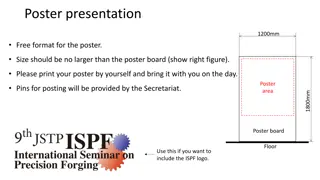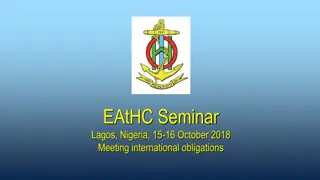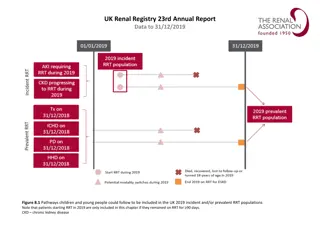
Progress in Heterogeneous Photocatalysis: Evolution and Applications
Explore the evolution of heterogeneous photocatalysis from classical radical chemistry to engineering nanomaterials and solar reactors. Discover the advancements in charge transport understanding, reaction mechanism identification, catalyst design, and photon delivery engineering. Dive into the global landscape of photocatalysis research output and the key role of molecular oxygen in organic degradation.
Download Presentation

Please find below an Image/Link to download the presentation.
The content on the website is provided AS IS for your information and personal use only. It may not be sold, licensed, or shared on other websites without obtaining consent from the author. If you encounter any issues during the download, it is possible that the publisher has removed the file from their server.
You are allowed to download the files provided on this website for personal or commercial use, subject to the condition that they are used lawfully. All files are the property of their respective owners.
The content on the website is provided AS IS for your information and personal use only. It may not be sold, licensed, or shared on other websites without obtaining consent from the author.
E N D
Presentation Transcript
Progress in Heterogeneous Photocatalysis: From Classical Radical Chemistry to Engineering Nanomaterials and Solar Reactors W.Y.Teoh, J.A.Scott and R.Amal J.Physical Chemistry Letters, 3, 629- 639 (2012)
Overview of Time Evolution of Photocatalysis The term functional designates photomediated redox reactions such as photocatalytic water splitting, environmental pollutant abatement, and organic synthesis. Ultimately, these applications were fuelled by the expectation of efficiently harnessing and utilizing freely available solar energy.
Schematic diagram of (a) the photoelectrochemical system using a TiO2 single crystal as the photoanode; (b) the corresponding energy diagram of the system (which is similarly applicable to); and (c) the miniaturizsed photoelectrochemical system in the form of suspended platinized TiO2 particulates. R denotes general organic electron- donor molecule
Number of publications pertaining to photocatalysis on a decadal basis originating from the top 12 (overall) publishing nations (topic: photocatalysis/photocatalytic/photocatalyst, ISI Web of Science, 12/01/2012). Besides the traditional photocatalysis powerhouses of Japan and the United States, the research output from China has dominated over the past decade, whereas South Korea and India have also experienced substantial growth in this field
Although it was substrate-specific, organic degradation was predominantly centered on direct (hole-mediated) and indirect oxidation reactions (mediated by hydroxyl and superoxide radicals) This was complemented by identifying the key function of molecular oxygen as an efficient electron scavenger, prompting system aeration or oxygenation when assessing photocatalytic oxidation reactions. Further interfacing with engineering saw effective photon delivery to the photocatalyst surface through light harvesting and photoreactor design. In this instance, photovoltaic (PV) conversion by excitonic (dyes, quantum dots, plasmonic) solar cells is a vanguard photocatalysis- related solution
(1)understanding charge transport (2), identifying the reaction mechanism, (3) designing an innovative photo-catalyst, and (4) engineering photon delivery
Possible reaction pathways arising from the excitation of photocatalysts. Included are primary redox reactions and selected ensuing secondary radical reactions. R denotes the general organic electron donor molecule
(OH(ads), E0ox > +1.6 VNHE ( OHfree, E0ox = +2.72 VNHE (O2 + e O2 -0.33 V). Singlet oxygen O2/OH2* = -005V O2/H2O2 - 0.33 V Multielectron reduction O2 + 2H+ + 2e +0.695 V O2 + 4H+ + 4e +1.23 V *CH2OH/CH2O -.95 V
chemisorbed oxygen can: (i) be reduced upon UV illumination, where it remains either in an undissociated state or dissociates to produce atomic oxygen species, or (ii) undergo hole- mediated desorption as molecular O2. Photo catalytic mechanism is intricate plus the Photo catalyst material and its history
Photo-catalytic materials and substrate specificity ZnO Hematite <10ps 2-4nmdiffusionlength Cr, MO or Si WO3 2.7 eV ECB below TiO2 P25 surface hydroxyl group density, crystallinity, size, specific surface area *OH generation
One of the most fundamentally intriguing issues in TiO2 photo-catalysis is the proposed synergistic effect between anatase and rutile, the two most dominant polymorphs heterojunction- (13-79%)
Noble metals like Pt,Ag,Au, Pd Rh Schottky barrier vs Fermi level work function and ECB dark catalytic effect of the metal deposited
RGO good electron transport scaffold large adsorption region for the pollutant. Z scheme
Organic dye sensitize and other functions have to be considered and hence making them as model systems need careful examination
Modification by doping and new photo- catalytic materials - introduction of foreign elements in the host matrix without new crystallographic phase net separation extend solar spectrum metal ions intrinsic energy levels electron or hole acceptors recombination (Fe).
Stability of the dopant Non metal N,C,S Oh radical or oxygen radical composite systems GaN:ZnO 2.4to 2.8 eVis lower than expected 3 from Zn 3d and Nitrogen 2p lead bismuth niobate, calcium bismuth zinc gallium systems.
Anisotropic photo-catalysts and other structures!D, Nanorods, wires, ribbons vectorial charge transport non electrochemical the effect may not be clear
Schematic diagram of the mobility path of photoelectrons upon bandgap excitation in: (a) a photoelectrochemical system comprising an aligned longitudinal photocatalyst array where an externally applied potential bias exists; (b) the corresponding suspended longitudinal photocatalysts; and (c) an aggregate of particulate photocatalysts. In the latter two systems, photoelectrons diffuse almost naturally to the reactive or charge trapping sites. Deep and shallow traps exist in all three systems, arising from various crystal defects and grain boundaries. U denotes the electrochemical potential of the photoelectrons driving their transport along the photocatalysts. .
Synthesis of photo-catalysts possessing alternate morphologies such as cube, pyramid, spinel, and fractals has also been extensively reported in recent years. Compared with the anisotropic design, these 3D structures are bound by their facets, each of which is energetically unique. In principle, the photo-catalytic redox sites as well as sites for preferential adsorption of reactants are dictated by the facets. Association of facet control with catalytic selectivity is a topic that has been thoroughly investigated in thermal (nonphoto) catalytic reactions
TiO2 {001} facet {00a}0.9Jm-2 {010 = 0.53;{101}0.44 (1) preferential adsorption of targeted reactants, (2) migration of charge carriers, (3) interfacial oxygen exchange/ mobility, and (4) product desorption.
They identified rutile {110} and anatase {011} as the reductive sites, whereas rutile {011} and anatase {001} acted as the oxidative sites. The reductive anatase {011} was further confirmed visually by single particle fluorescence spectroscopy
Photon Delivery. No matter how active a photo- catalyst, if photons are not effectively transmitted to its surface then its full potential will not be reached and system efficiency will be lowered. Consequently, this aspect deserves to be mentioned as it represents a key component of any successful photo-catalytic array. The challenge lies in ensuring that the photo- catalytic rate is not limited by a poor illumination strategy. However, effective photon delivery has to be balanced with mass transfer effects, with the two mainly governed by photo-reactor style
Schematic diagram of: (a) Channelled optical fiber reactor (COFR) system for the gas-phase photocatalytic degradation of VOCs inset shows a cross sectional view of the COFR and its dimensions and (b) light reflection and refraction from/across a quartz photoreactor wall coated with (i) mesoporous SiO2 only and (ii) a mesoporous SiO2 optical barrier between the wall and a TiO2 coating Pi = incident light, Pr = reflected light, = incidental angle.
Mukherjee and Ray defined four photoreactor groups slurry, immersion, distributive, and external illumination with each class providing superior performance in terms of photon delivery or mass transfer, but rarely both For instance, slurry photoreactors facilitate mass transfer; however, in the context of uniformly supplying photons to the surface they are limited by poor light penetration into the suspension. An alternative to slurry photo-reactors is thin film systems where the photo-catalyst is present as a thin film on the reactor walls. This reactor variety promotes illumination but at the detriment of mass transfer. The coated area may be increased by packing with a material (e.g., beads, fiberglass mesh) coated with the photocatalyst, although again this is at the expense of light penetration. Distributive systems, such as those employing optical fibres as waveguides, allow for the two criteria to be satisfied however, complications with uncontrolled light refraction across the coated interface hamper this technology. Recent efforts by ourselves and others have focused on overcoming this issue by modifying optical fiber design (Figure 6a) or by using an intermediate coating (Figure 6b) with some success
Outlook and Concluding Remarks. The growth of heterogeneous photocatalysis has been and will continue to be application-driven, supported by strong process fundamentals. Solar water splitting and environmental remediation, which are the mainstay applications, will continue to serve as important platforms for showcasing photocatalytic technologies as well as motivation for establishing relevant fundamental knowledge. In addition, the photocatalytic conversion of carbon dioxide to fuels and other useful chemicals is expected to be a dominant area and contribute new knowledge, be it the reaction mechanisms, materials design, or reactor design. Whereas successes in pursuing the different areas of photocatalytic applications are highly rewarding, it is critical to remember that establishing fundamental depth in photocatalysis is the shared responsibility of scientists and engineers alike. At the same time, continuous bridging of interdisciplinary knowledge has been identified, at least within this Perspective, as one of the most important elements to warrant sustainable growth of the field for many years to come.





